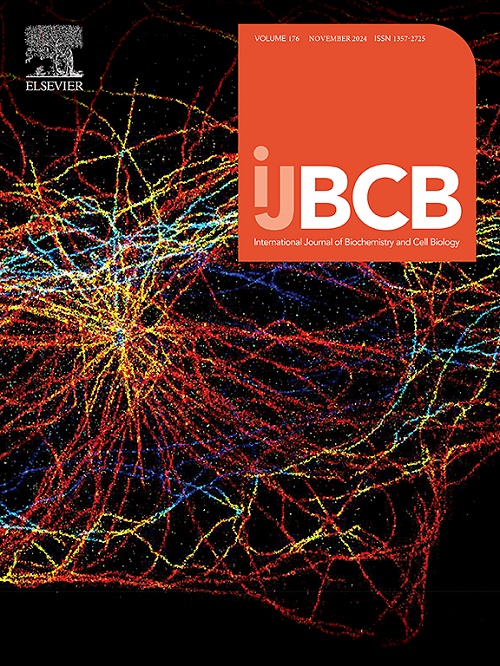Long non-coding RNA AC105118.1 affects glycolysis to facilitate oxaliplatin resistance in colorectal cancer cells by modulating the miR-378a-3p/KIF26B axis
IF 2.8
3区 生物学
Q2 BIOCHEMISTRY & MOLECULAR BIOLOGY
International Journal of Biochemistry & Cell Biology
Pub Date : 2024-11-12
DOI:10.1016/j.biocel.2024.106692
引用次数: 0
Abstract
Background
Oxaliplatin is a first-line chemotherapy drug for colorectal cancer (CRC), but many patients eventually lose treatment efficacy due to acquired resistance. AC105118.1 is a long non-coding RNA with unknown biological function. This research attempts to probe into the molecular regulatory mechanism of AC105118.1 in CRC oxaliplatin resistance.
Methods
The expression level of AC105118.1 in CRC tissues and cells was measured based on The Cancer Genome Atlas (TCGA) data and quantitative reverse transcription polymerase chain reaction (qRT-PCR). We utilized dual-luciferase assay and RNA immunoprecipitation to analyze the interaction between AC105118.1, miR-378a-3p, and their downstream target KIF26B. CCK-8, colony formation assay, and flow cytometry were employed to assess the half inhibitory concentration (IC50), cell proliferation, and apoptosis rate of HCT116/L-OHP cells treated with oxaliplatin. The glycolysis evaluation was completed by measuring the extracellular acidification rate (ECAR), glucose consumption, lactate production, and glycolysis-related proteins (HK2, GLUT1, and LDHA). TUNEL staining was used to detect the level of apoptosis.
Results
AC105118.1 was specifically upregulated in CRC tissues and cells. AC105118.1 indirectly facilitated the expression of miRNA target gene KIF26B by sequestering miR-378a-3p. In HCT116/L-OHP cells, transfection with si-AC105118.1 resulted in a decrease in glycolysis level, a lower maximum IC50 required for oxaliplatin-treated cells, inhibited cell proliferation, and an increase in apoptosis rate. All of these effects were alleviated when simultaneously transfecting miR-378a-3p inhibitor or oe-KIF26B. Knockdown of AC105118.1 significantly inhibited oxaliplatin resistance to CRC in mice.
Conclusion
AC105118.1 facilitates glycolysis and increases CRC cells’ resistance to oxaliplatin by targeting the miR-378a-3p/KIF26B axis. The present work shed new insights into the function and mechanism of AC105118.1 in molecular function and suggested that the AC105118.1/miR-378a-3p/KIF26B axis is a promising target for intervening CRC oxaliplatin resistance.
长非编码 RNA AC105118.1 通过调节 miR-378a-3p/KIF26B 轴影响糖酵解,从而促进结直肠癌细胞对奥沙利铂的耐药性。
背景:奥沙利铂是治疗结直肠癌(CRC)的一线化疗药物:奥沙利铂是结直肠癌(CRC)的一线化疗药物,但许多患者最终因获得性耐药性而失去疗效。AC105118.1 是一种生物功能未知的长非编码 RNA。本研究试图探究 AC105118.1 在 CRC 奥沙利铂耐药性中的分子调控机制:方法:根据癌症基因组图谱(TCGA)数据和定量反转录聚合酶链反应(qRT-PCR)测定AC105118.1在CRC组织和细胞中的表达水平。我们利用双荧光素酶测定法和 RNA 免疫沉淀法分析了 AC105118.1、miR-378a-3p 和它们的下游靶标 KIF26B 之间的相互作用。CCK-8、集落形成试验和流式细胞术用于评估奥沙利铂处理 HCT116/L-OHP 细胞的半数抑制浓度(IC50)、细胞增殖和凋亡率。糖酵解评估是通过测量细胞外酸化率(ECAR)、葡萄糖消耗量、乳酸生成量和糖酵解相关蛋白(HK2、GLUT1 和 LDHA)来完成的。TUNEL染色用于检测细胞凋亡水平:结果:AC105118.1在CRC组织和细胞中特异性上调。结果:AC105118.1在CRC组织和细胞中特异性上调,它通过封存miR-378a-3p间接促进miRNA靶基因KIF26B的表达。在 HCT116/L-OHP 细胞中,转染 si-AC105118.1 会降低糖酵解水平,降低奥沙利铂处理细胞所需的最大 IC50,抑制细胞增殖,并增加细胞凋亡率。如果同时转染 miR-378a-3p 抑制剂或 oe-KIF26B,所有这些影响都会减轻。敲除 AC105118.1 能显著抑制小鼠奥沙利铂对 CRC 的耐药性:AC105118.1通过靶向miR-378a-3p/KIF26B轴促进糖酵解并增加CRC细胞对奥沙利铂的耐药性。本研究揭示了AC105118.1在分子功能中的作用和机制,并认为AC105118.1/miR-378a-3p/KIF26B轴是干预CRC奥沙利铂耐药性的一个有前景的靶点。
本文章由计算机程序翻译,如有差异,请以英文原文为准。
求助全文
约1分钟内获得全文
求助全文
来源期刊
CiteScore
8.10
自引率
0.00%
发文量
124
审稿时长
19 days
期刊介绍:
IJBCB publishes original research articles, invited reviews and in-focus articles in all areas of cell and molecular biology and biomedical research.
Topics of interest include, but are not limited to:
-Mechanistic studies of cells, cell organelles, sub-cellular molecular pathways and metabolism
-Novel insights into disease pathogenesis
-Nanotechnology with implication to biological and medical processes
-Genomics and bioinformatics
文献相关原料
公司名称
产品信息
阿拉丁
trypsin

 求助内容:
求助内容: 应助结果提醒方式:
应助结果提醒方式:


